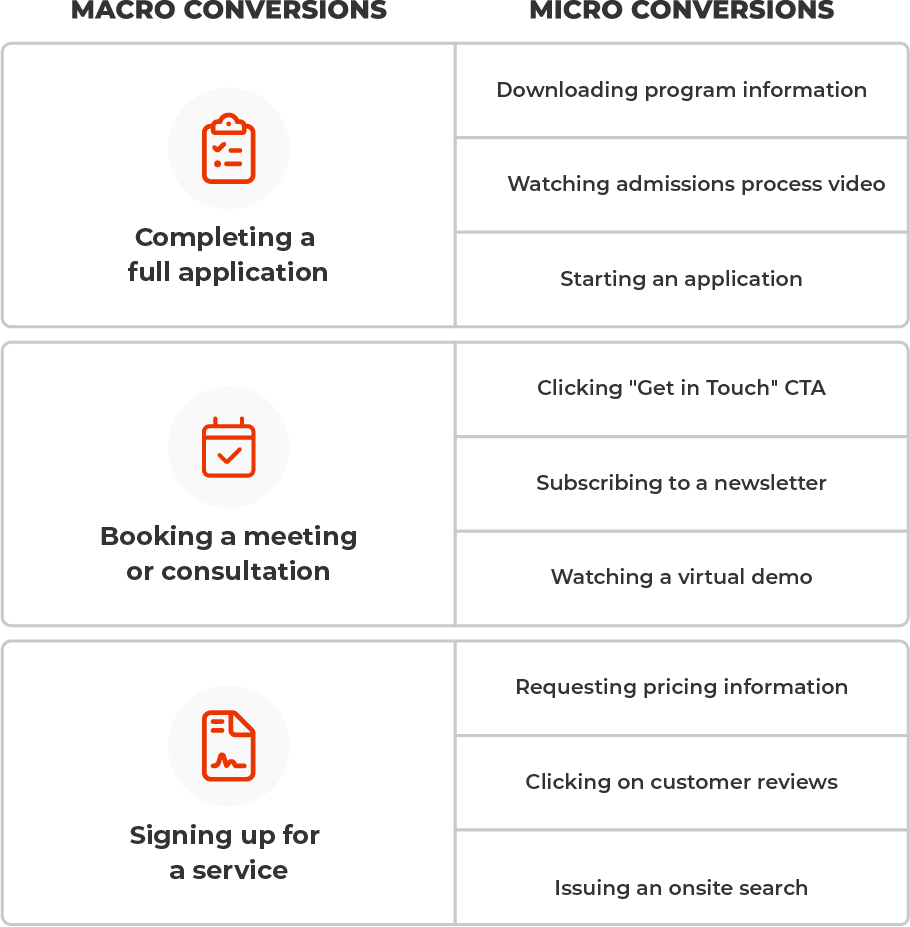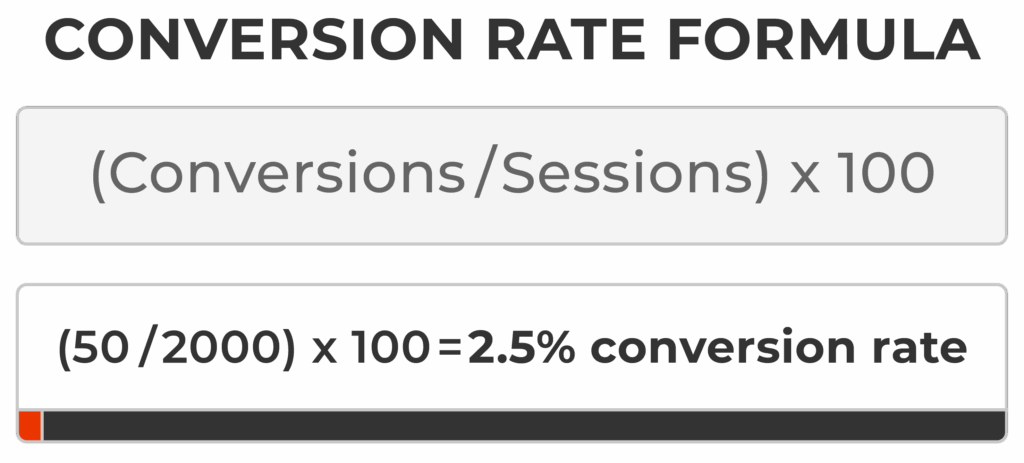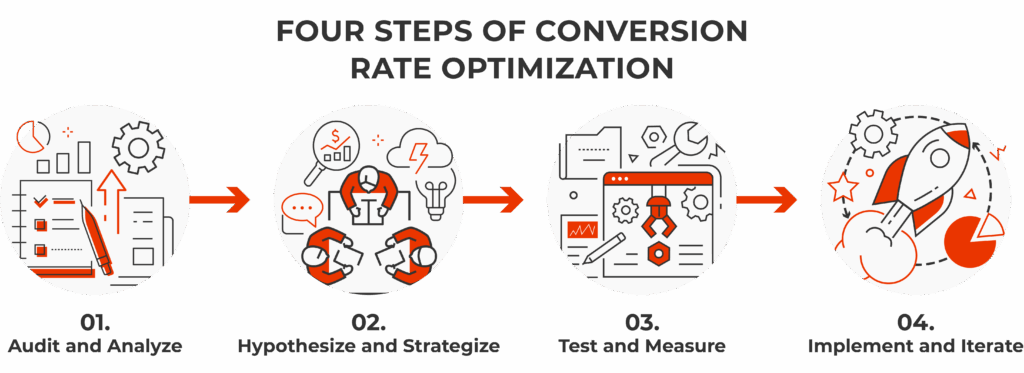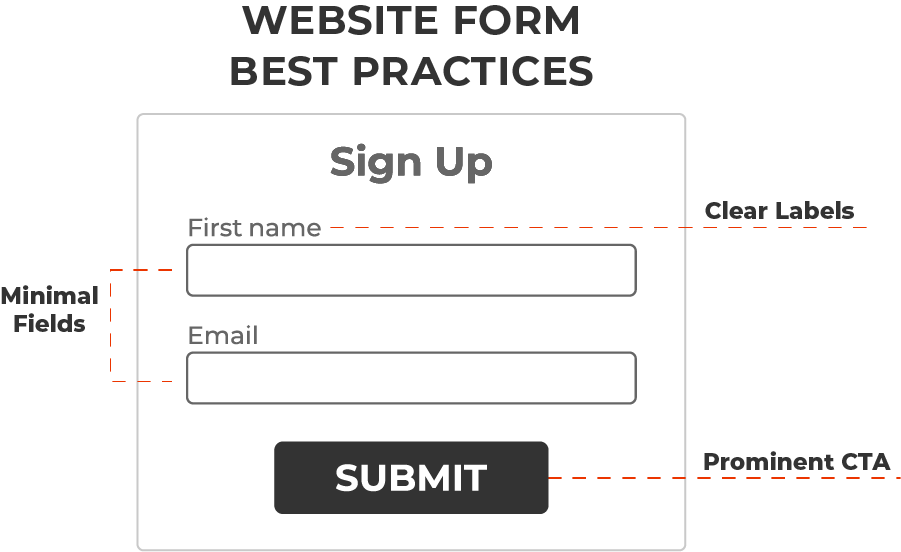May 30, 2025
Allison Miriani
|
Every website visitor has potential. Whether you’re in higher education, healthcare, government or B2B services, each click signals intent.
Conversion Rate Optimization helps you harness that intent, refine your digital experiences, and turn curiosity into meaningful action.
This guide will walk you through what conversion rate optimization is, why it matters for content-rich websites and how to use tactics like site search analytics and behavioral data to make smarter, more impactful marketing decisions.
What Is Conversion Rate Optimization (CRO)?
Conversion Rate Optimization is the process of improving your website’s design, content and user experience to increase the percentage of visitors who take a specific, desired action—called a conversion.
On content-driven websites, those actions might include:
- Filling out a program inquiry form
- Downloading a whitepaper or research report
- Requesting a demo or callback
- Registering for a webinar or campus visit
- Signing up for a newsletter or updates
Unlike ecommerce, where a “conversion” often means a purchase, CRO for content-rich sites focuses on deeper engagement that fuels long-term outcomes like enrollment, patient intake, vendor interest or community participation.
Real-World Example:
A health system may use CRO to optimize their “Find a Provider” tool. When patients can easily search by specialty, see availability and book an appointment within a few clicks, the conversion rate on that page spikes—resulting in more scheduled visits and improved care access.
What Counts as a Conversion?
A conversion is any completed action that helps your organization reach a goal. For content-heavy organizations, that might not always be tied to revenue.
Macro vs. Micro Conversions:
- Macro conversions: Completing a full application, booking a consultation or signing up for a service
- Micro conversions: Watching a video, clicking a call to action (CTA), using site search or downloading a resource
Here’s a list of examples conversion events and how you would categorize them for your site:

Examples by Industry:
- Higher Education: A prospective student registers for a virtual open house (macro), but first downloads a program guide (micro).
- B2B Services: A visitor requests pricing information after reading a case study.
- Government: A citizen signs up for local emergency alerts after navigating to a services page.
Tracking both types of conversions helps you better understand the user journey and identify where improvements are needed.
How to Calculate Conversion Rate
The basic formula for calculating conversion rate on your website:
(Conversions ÷ Total Sessions) × 100 = Conversion Rate
Example:
50 form submissions from 2,000 sessions = (50/2000) x 100 = 2.5% conversion rate

Specific tools to track sessions and conversions:
- Google Analytics 4 (GA4)
- Matomo
- HubSpot or Salesforce integrations
Key supporting metrics:
- Click-through rate (CTR)
- Bounce rate
- Time on page
- Pages per session
- No-result search queries
Why CRO Matters for Content-Rich Sites
Many content-rich websites are built to inform, not convert. But information alone won’t move someone to act unless the experience guides them there intuitively.
For example:
A university might publish dozens of pages per month about different degree programs. But if the “Request More Info” button is buried at the bottom or missing entirely, conversion suffers. So the on-page UX and placement of the call to action makes a huge difference.
The same goes for healthcare systems who may outline services in-depth, but without an easy path to book an appointment, users may look for nearby health systems or hospitals. It’s all about finding that path of least resistance for visitors to gain access to the content and services they need. In healthcare, there’s a huge premium on connecting patients with essential services.
With conversion rate optimization, your job as a marketer becomes helping users connect the dots between intent and action.
This means:
- Structuring content to reduce friction
- Testing CTAs, layouts, and messaging
- Analyzing behavioral patterns like search usage and scroll depth
- Continuously optimizing based on what your visitors are telling you with their actions
3 Conversion Rate Optimization Principles That Drive Results
1. Understand User Behavior
CRO starts with listening. Your website is already collecting valuable behavioral data—you just need to interpret it.
Use tools like:
- Heatmaps to see where users are clicking through to key content or dropping off
- Session recordings to watch real user interactions
- Onsite search analytics to uncover content gaps and trends
What to look for:
- Are users scrolling but not clicking?
- Are certain pages getting a high exit rate?
- Are people using your search bar to find content they couldn’t access through navigation?
2. A/B and Multivariate Testing
You don’t have to guess what works—you can test it.
- A/B Testing: Compare two versions of a page or CTA to see which performs better
- Multivariate Testing: Test different combinations of elements (headlines, images, CTAs) to optimize holistically
Best practices:
- Focus on one variable at a time for clarity in A/B tests
- Run tests long enough to reach statistical significance (typically 2–6 weeks)
- Start with high-traffic pages for faster results
- Multivariate testing requires much higher traffic and sample sizes than A/B tests
3. Conversion Psychology
Understanding decision-making psychology helps create pages that convert.
Key concepts:
- Reciprocity: Offer something valuable (a guide, checklist) before asking for contact info
- Foot-in-the-door: Start with small asks, like email opt-ins, before pushing for full form submissions
- Social proof: Display testimonials, ratings or “X people downloaded this”
Urgency: Use deadlines or limited-time CTAs to encourage action
Site Search: Your CRO Secret Weapon
If you’re not optimizing based on onsite search behavior, you’re missing one of the clearest indicators of user intent. It’s free first-party data that’s naturally being typed into your search bar regularly.
When someone uses your onsite search feature, they’re:
- Telling you what they want in their own words
- Trying to overcome friction in your navigation
- Giving you a blueprint for better content and CTAs
What’s more, we know that younger generations, like Gen Z, prefer using the search bar on a website to find exactly what they need. They’re used to the experiences they have on their favorite apps and websites they’ve grown up with, like Spotify and TikTok, where search is a primary discovery method.
So while today, an average of 43% of users go straight to the search bar when they land on a website, that number is expected to climb as Gen Z enters college and the workforce.
Site Search Metrics to Monitor:
- Top search queries
- No-results searches
- Post-search CTR
- Search-to-conversion rate
CRO Opportunities from Search Data:
- Content Gaps: If users are searching for something that doesn’t exist or is outdated, that’s a signal to create or improve content to fill that gap and connect to user intent
- CTA Placement: Align CTAs to highly searched topics and pages
- Search Tuning and Promotions: Promote top-performing content in the search interface
Example:
The marketing director of a government site notices “license renewal” is frequently searched, but the content is buried three clicks deep. They move it to the homepage and promote it to the top of the search results to make it easily accessible for anyone who needs that resource. From there, they add a one-click form—boosting completions by 40%.
The Conversion Rate Optimization Process in Four Steps
Following a step-by-step process is essential for organizing and testing your CRO efforts. Here are the four steps to follow:

1. Audit and Analyze
Start with the data you already have pouring into your website:
- Google Analytics reports
- Scroll maps and heatmaps
- Search logs and exit rates
- On-page engagement metrics
Use surveys to collect qualitative insights – you can do this through services and agencies who will share your pages for testers who accurately simulate your audience. Get answers to questions like:
- What are visitors trying to do?
- Where are they getting stuck?
- What are they frustrated by?
- What messaging and UX elements resonate?
2. Hypothesize and Strategize
Based on your findings, form clear hypotheses of what updates will make the biggest impact.
Example:
- Hypothesis: Moving the program guide CTA above the fold on program pages will increase downloads.
- Strategy: Update page layout and test against original version using A/B testing.
3. Test and Measure
Use A/B or multivariate testing platforms to:
- Launch experiments
- Track results
- Adjust variables as needed
Make sure to:
- Give tests enough time (2–6 weeks)
- Ensure you have the right sample size
- Segment users (e.g., mobile vs desktop)
- Use consistent reporting tools
4. Implement and Iterate
Once you have statistically significant results:
- Roll out winning changes sitewide
- Document what worked and why
- Revisit high-impact pages regularly
Remember: CRO is never one-and-done.
Not only is there always room for improvement, but there are constantly new ways to engage website visitors. This is especially true for content-rich sites who are publishing dozens of pages (or more) per month.
How do you make those new resources easy to find on your site, especially if they have a CTA or other conversion element that you need visitors to interact with? One of the fastest ways to make meaningful content discovery changes is to continually test and tune your onsite search.
Where to Focus Your CRO Efforts
Landing Pages
Landing pages are your bread and butter for packing in meaningful content that will educate and engage your audience. But you have to be strategic about how you optimize copy, images and UX elements on your pages.
Key tips:
- Compelling, benefit-driven headline
- Clear CTA above the fold
- Limited navigation (keep users focused)
- Strong visual hierarchy
Forms
Forms are powerful conversion tools, but you need to make them lean enough to encourage visitors to fill them out. You also need to make sure the offer aligns with the effort of filling them out (never underestimate how much visitors just want to scroll quickly and not be “bothered”).
Optimize by:
- Reducing required fields
- Using multi-step formats for longer forms
- Adding inline validation (e.g., “This field is required”)
- Pre-filling known fields (e.g., from email links)
- Making sure the value of what users will get post-form is crystal clear and attractive
- Adjust the form based on your goals and audience – testing is key

Onsite Search Results Pages
Your onsite search results pages shouldn’t just be a plain list of linked pages. You should have filtering options and elements to guide the eye to important/new content. Onsite search results pages should get the same level of consideration for engagement and conversion that your prominent landing pages get on your website.
Improve site search results with:
- Filters and facets to easily narrow results
- Visual cards with context (e.g., titles, dates, thumbnails)
- Highlighting matched keywords (hit highlighting)
Website Speed and Mobile Experience
Your specific conversion rate optimization efforts will mean nothing if visitors bounce out of your site before they’ve even experienced your content. That’s what can happen when you have long loading times or a mobile experience that doesn’t match what you offer on desktop. CRO actually starts at the front door, right when your visitors land on your site.
Tools like Google PageSpeed Insights can help you uncover less visible performance issues – such as large file-size images, unnecessary scripts or slow-loading above the fold- content. Address these insights to deliver a faster, smoother experience for website visitors.
Ensure mobile usability by:
- Avoiding long forms
- Using sticky CTAs
- Designing tap-friendly interfaces
Advanced Conversion Rate Optimization Tactics for Marketers
Personalization
Personalized content that speaks to a user’s specific persona and needs will always perform better – this goes for everything from content marketing to email marketing and beyond.
For marketers looking to improve conversion rate optimization, personalization can make all the difference. In fact, a Hubspot study shows that personalized CTAs perform up to 202% better than basic CTAs. That’s a powerful lever that you can tap into.
Tailor content based on:
- User behavior (visited X page = show Y offer)
- Geo-location (show local campus or service area)
- Referral source (custom CTAs for ad visitors)
- Site search data (onsite search keywords and phrases most used)
And don’t forget to make sure the personalized content actually reaches your prospects. For example, to make sure emails actually reach users, it’s important to verify your domain settings first. A DNS Record lookup can help confirm that all records are correctly configured, improving deliverability and overall campaign performance.
Mobile Optimization
Website optimization does not stop at the big screen. The majority of global web traffic favors using a mobile device, with nearly 63% of the traffic share (Statista – January 2025).
Think mobile-first:
- Design for thumb navigation
- Use sticky buttons for common actions
- Avoid heavy media or unnecessary pop-ups
Common Conversion Rate Optimization Mistakes to Avoid
Here’s a shortlist of the common CRO pitfalls for marketers who are looking to level up their site’s conversion rate:
- Ending tests too early
- Testing too many elements at once
- Ignoring the mobile experience
- Failing to review site search behavior
- Focusing only on page design, not messaging or flow
CRO Is an Ongoing Practice
If your website drives interest, awareness or education, you’re already in the CRO game. The question is: Are you listening closely enough to what your visitors are telling you through their actions on your site?
By combining behavioral insights, thoughtful testing and tools like site search analytics, you can build a web experience that’s not just helpful—but high-converting.
Ready to start? Explore our Site Search Solution to see how marketers in higher ed, healthcare and government and beyond are using intent data to guide conversion rate optimization decisions that move the needle.




